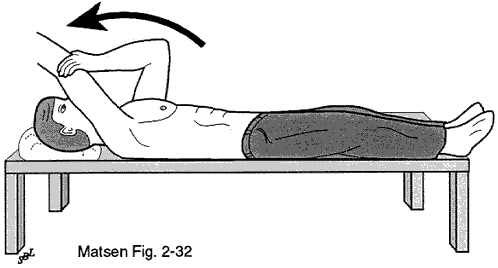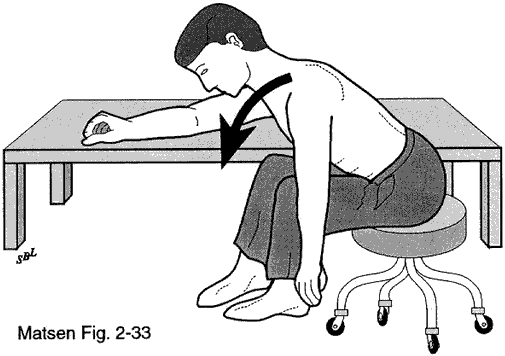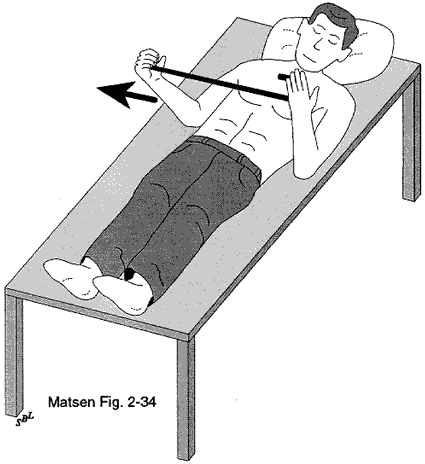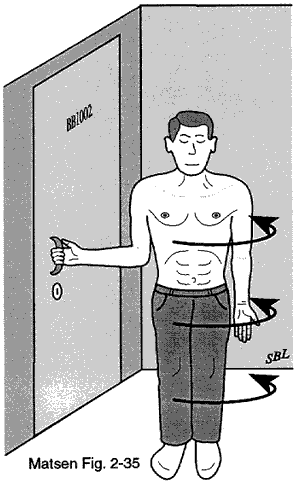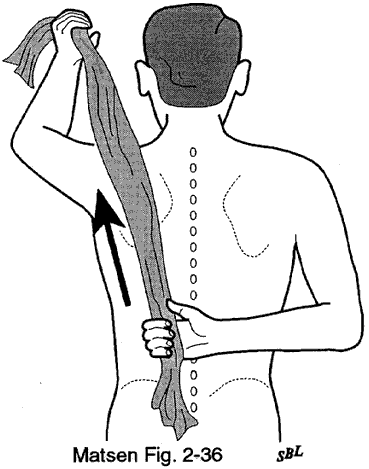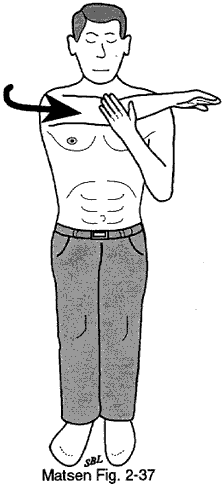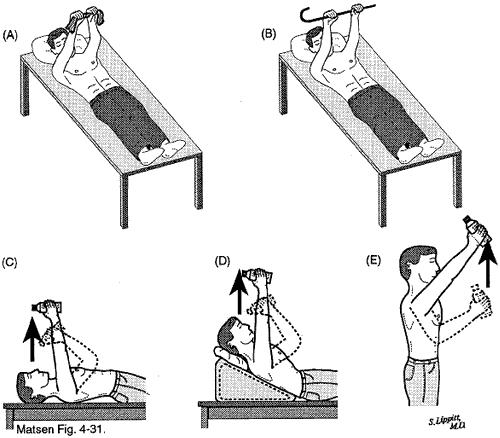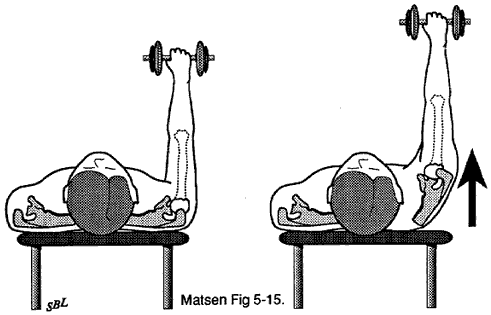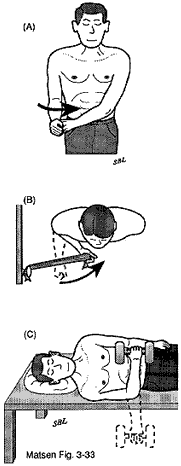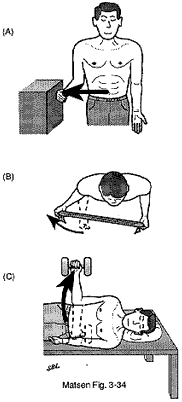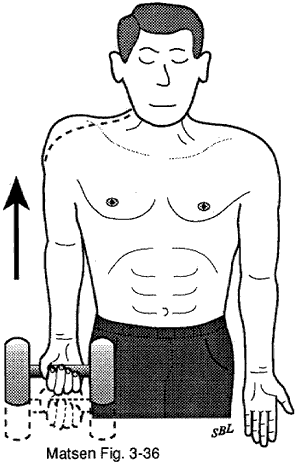Shoulders can lose their normal smoothness of motion for a wide variety of reasons. In many situations the roughness is related to tightness of the soft tissues around the joint to abnormal posture or to shoulder weakness.
About exercises for the rough shoulder
Normally the shoulder is flexible allowing the shoulder to maintain its usually large range of motion. When shoulder tissues become thickened or scarred they lose their normal resilience suppleness strength and smoothness. Even if you have had an injury or if there is some arthritis in your shoulder it is likely that you can benefit from a simple home program to optimize your shoulder's comfort and function. Before beginning these exercises you should consult with your physician.
There are three components to the home program for rough shoulders. The first is a series of stretching exercises the second involves strengthening and coordination and the third relates to regular participation in a fitness program.
Stretching
Your opposite arm is a great therapist for your rough shoulder. Your "therapist arm" is always available to apply a gentle stretch in any direction of tightness. Each of these gentle stretches needs to be held up to a count of 100.
Stretching exercises
The basic program includes the exercises illustrated here:
overhead while lying down
overhead while lying down
overhead while sitting
overhead while sitting
overhead with a pulley
rotate while lying down
rotate while lying down
rotate while standing
rotate while standing
up the back
up the back
across the body
across the body
If other directions of roughness are identified they can be stretched with a similar approach. An importantta principle of the stretching exercises is to allow your muscles to relax so that the stretch can be applied to the soft tissues without muscle interference. Tissues of a tight shoulder do not like to be stretched suddenly roughly or with a lot of force. Thus the strategy is to apply a gentle stretch so that at most minimal soreness results. Any soreness should go away within 15 minutes after you stop the exercises.
You should carry out this shoulder stretching sequence three times a day. As much as possible these sessions should be performed after the shoulder has been relaxed by a hot shower bath or aerobic exercise. For each stretch make a note of the maximum range obtained with each session. Try to establish a new "bench mark" each time you do them so that you can see your progress each time.
The beauty of this exercise program is that you are in control. You can adjust the vigor of the stretching to do what is most easily tolerated by your shoulder. The exercise program is totally portable and can be performed in your home office car the bus the airplane or wherever you happen to be. This is important because consistency in this exercise program pays off. If pain results from the exercise program do not stop or change the frequency of your exercise sessions just reduce the vigor of the stretches so that they become comfortable.
Strengthening and Coordination
The exercises described below are often used to strengthen shoulders and help with their coordination. These exercises should be comfortable while they are done and afterwards. They should be starte
Strengthening exercises
One of the most important actions to strengthen a rough shoulder is forward elevation. The main exercises are illustrated here:
The nice thing about these exercises is that you can do them by yourself and can adjust your rate of progress according to what is most comfortable for you. The series proceeds in small steps. Start by lying on your back grasping a bar with both hands together. Push the bar straight up toward the ceiling. At the end of each push lift your entire shoulder off the bed or floor. When you can do this 20 times easily separate your hands an inch or so when you push the cloth toward the ceiling. This places slightly more of the load on the muscles of your weaker shoulder.
As the exercise gets easier separate your hands more on the washcloth until you can push your hand toward the ceiling without any assistance from the opposite arm. Practice this exercise with nothing in your hand until you are able to repeat it 20 times. Then take an empty pint container and perform the same movement pushing it toward the ceiling. Add water to increase the resistance slowly. When the container is full of water the weight is about one pound. Make sure that with each press-up you end by lifting your shoulder blade up off the bed or floor. Be sure that you can perform the movement comfortably 20 times at each stage before advancing to the next stage. When you can press one pound toward the ceiling 20 times the next step is to perform the exercise with your back propped up slightly on pillows or by using a recliner or garden chair. When 20 comfortable repetitions are possible increase the degree to which your back is propped up. At each level push the shoulder all the way up: "press plus". Continue this process until you are able to push the one pound weight 20 times toward the ceiling in a sitting position. Work for smooth slow controlled motions.
This program optimizes the mechanics of your shoulder and gives you the best chance of regaining good function.
Rotator cuff strengthening exercises
Shoulder shrugs to strengthen trapezius
Other important strengthening exercises
Click to enlarge
Exercise and Arthritis:
Table push ups
Coordination exercises
About fitness exercises
Regular fitness exercise helps keep your joints supple. This "lubricating" effect is optimized if you perform a half-hour of aerobic exercise each day. This exercise may take a variety of forms including brisk walking, jogging, riding a stationary or mobile bicycle rowing, climbing stairs or using a cross-country skiing simulator. If you have concerns about your ability to carry out such an exercise program you should consult your general physician. It is not important that these exercises be carried out vigorously it is only important that in addition to the stretching program a half an hour of your day be devoted toward some form of aerobic exercise. A guideline for someone with a healthy heart lungs and blood pressure is to work up to 30 minutes of exercise at a target of two-thirds of his or her maximum heart rate. Your maximum heart rate is estimated by subtracting your age from 220. If you are over 35 and have not been exercising much or if you are not sure of your health you should consult your doctor before starting this aspect of the program.
What if you have already "had therapy?" Our repeated observation is that many patients who have not responded to formal therapy sessions can still improve their shoulder function using a home program in which they are in charge. Remember that your shoulder problem has been present for quite a while. Improvement in your range of motion strength smoothness and comfort may not be noticeable until six weeks of persistence with the program.
We have found that medication is not very helpful in managing rough shoulders. Mild analgesics (such as aspirin ibuprofen or acetaminophen) may be used in conjunction with this program if desired. Narcotic medications "muscle relaxants " and sleeping pills have not proved helpful to our patients.
You may be able to use your shoulder actively within the range of comfort. For example, if you can do some water exercises or swimming without aggravating the shoulder, please do so. On the other hand, activities which produce shoulder pain should be avoided.
If you have any questions about your shoulder or the proper treatment, let your doctor know.
Last Updated: October 09, 2006

